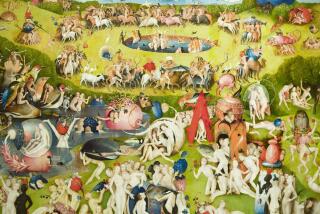Off The Shelf: A writer’s fascination with a pipe opens up a world of fantasy
When I was growing up, my dad had a family heirloom that fascinated me: a small tobacco pipe with a glass-covered pinhole in the side. If you looked through the hole you could see a microfiche-like photograph: four rows of stern-looking men and women, along with names and other information in German or Dutch.
My dad explained that the photograph depicted a group of dissidents from the days before World War I. He didn’t know whether the image was intended as a “hit list” for the secret police or a way for the radicals to keep track of their own. But those kinds of details didn’t register with me anyway. For me, the pipe was a compelling oddity, a window that delighted me because I could look through a tiny hole and see so much.
Over the years, I kept thinking about that pipe -- my mind just wouldn’t leave it alone. Then, while working on my noir fantasy novel “Finch” (Underland Press: 320 pp., $14.95 paper), it resurfaced as belonging to the father of my detective hero, John Finch. Finch’s father is a mysterious figure with shifting allegiances between various factions in my war-torn imaginary city of Ambergris.
In a scene in the novel, Finch is shown the pipe as a child, much as I was shown the real pipe by my dad. Here, though, there is an added layer: that Finch’s father is trying to communicate something about his real role in Ambergris that he cannot state directly without endangering his son. Finch looks through the pinhole and sees “[a] whole map of the known world. There was a dot for Ambergris. The line of the River Moth. . . . The Kalif’s empire covering the west beyond the Moth. Exotic city after exotic city marked in that vast desert, the plains and hills beyond.”
But my fictional pipe also has a pinhole on the other side, which shows “black-and-white photos of twelve men and women.” Finch’s father tells him, “The owner of this pipe ran a network of spies. The map . . . is really a code. It tells the owner something about the spies whose pictures you’re looking at.”
A secret history of the world. A topography of the imagination in which cities become shorthand for people’s lives. For me, writing fantasy has always had that element. Each novel has contained autobiography tied to setting -- with details taken directly from the exhilarating and mundane aspects of my past and my family’s past. Do readers see those elements as personal, as transposed from reality? Probably not in most cases, and it certainly isn’t necessary.
But it’s this hidden element, this strand of subtext, that -- unseen by readers but felt by them -- breathes life into fiction and is especially important for fiction set in imaginary places, which might otherwise be so disconnected from reality as to become meaningless. A novel that isn’t anchored to some aspect of the human condition, to some universal aspect of our disparate experiences, is usually a novel inert and lifeless on the page.
This subtext acknowledges that what’s private is also public, that the world beyond our immediate experience has an impact on us and thus on our fiction. As a kid, my father’s pipe represented a potent possibility for adventure, a sense that the world was deeper and wider than I could then know. It also represented a way of bonding with my dad.
But as an adult, it became a different kind of mystery, with a different set of questions. Who were these people trapped inside the pipe? What had they lived for? What had they been willing to die for?
Slowly, the political mixed with the personal, and yet I didn’t want the real answers. My mind was seeking fictional ones instead.
I found them in writing “Finch.” The novel is set in a failed state run by a dictatorship that doesn’t understand the people it is governing. The consequences are both tragic and absurd. Although “Finch” has a mystery plot wedded to a surreal fantasy element, the context, the setting, the lives of the characters are informed and shaped by the last eight years, from Sept. 11 to occupation to torture to suicide bombings.
Writers often mention the need to get distance from events in their lives before they deal with them in fiction, but I find a similar need for distance from history and politics. Without that -- and the transformative power of the imagination -- a fiction writer risks creating an unsubtle polemic. Writing in a fantastical setting helps me, as it immediately changes the paradigm, while retaining the intellectual arguments and questions, the tone and texture, of the original events.
To me, then, fantasy continues to be highly personal because the political, the historical always takes a toll, even on those of us who occupy the sidelines. As a writer, you cannot remain unaffected by that, even if you sometimes can’t see how to work with it. Ambergris enables me to write about it. Fantasy enables me to write about it. That prism is like putting my eye to the hole in the pipe and seeing this fragment of another world that’s still part of our own, no matter how distant in time or space.
The truth is, Ambergris has always been porous: There’s no barrier between me and it, and thus no barrier between it and the world. The world continually horrifies, moves, elates, bores and changes me -- and, in a very organic, intimate way, Ambergris is continually being colonized and redrawn in my imagination as a consequence. There are no maps of Ambergris because there can be no maps of Ambergris, no matter what an image in a pinhole tells you. In “Finch,” it is a beleaguered city, linked by psychic distress to places like Baghdad, Beirut, even occupied Paris during World War II. But what will it be tomorrow?
VanderMeer reads from “Finch” at 7 p.m. Nov. 11 at Book Soup.
More to Read
The biggest entertainment stories
Get our big stories about Hollywood, film, television, music, arts, culture and more right in your inbox as soon as they publish.
You may occasionally receive promotional content from the Los Angeles Times.










